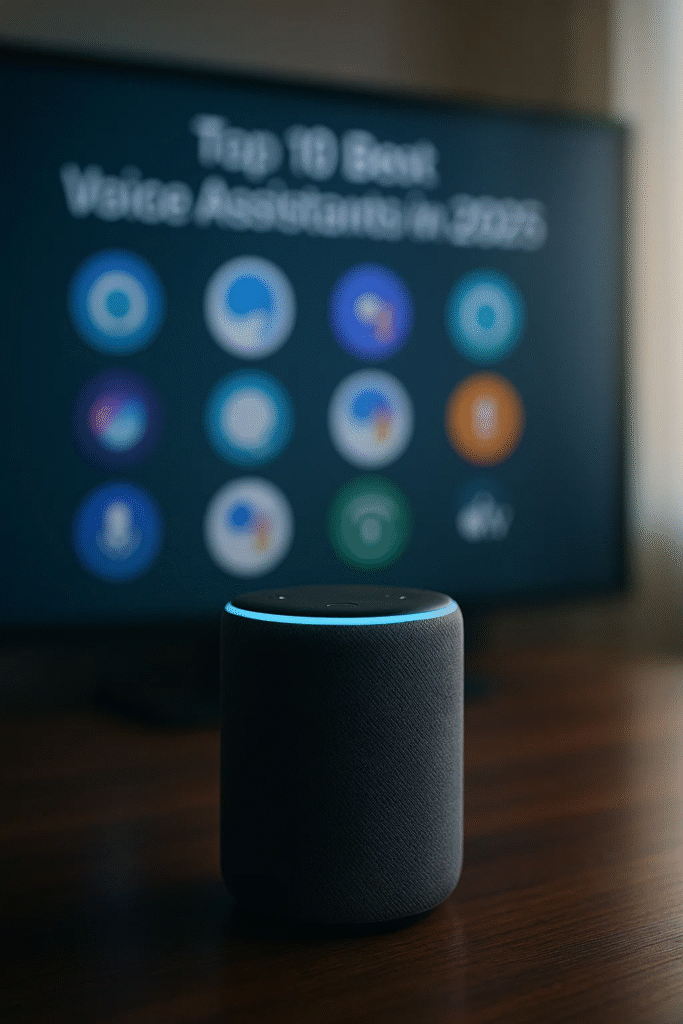Key Takeaways
- Voice assistants in 2025 offer advanced features like real-time transcription, multilingual support, and seamless smart device integration.
- Enterprise-grade solutions are focusing on automation, AI-driven insights, and omnichannel communication to boost productivity and reduce costs.
- Top platforms like Alexa, Google Assistant, SoundHound, and Otter AI lead the market with innovative AI capabilities and user-centric design.
In today’s rapidly evolving digital landscape, voice assistants have become more than just a technological novelty—they are essential tools that enhance productivity, streamline everyday tasks, and offer an unprecedented level of convenience. As we step deeper into 2025, voice assistant technology has matured significantly, integrating artificial intelligence, natural language processing, and machine learning to deliver faster, smarter, and more personalized user experiences across devices and ecosystems.

From smart home automation and hands-free smartphone usage to real-time translation and advanced business functionalities, voice assistants are now deeply embedded in both personal and professional spheres. Consumers are no longer satisfied with basic voice commands; they now demand seamless interaction, contextual awareness, multilingual capabilities, and proactive support. As a result, developers and tech giants have raced to refine their virtual assistants, pushing the boundaries of what’s possible with voice-activated AI.
The voice assistant market has witnessed remarkable innovations in 2025. Whether you are using an iPhone, Android phone, smart speaker, wearable device, or even a vehicle infotainment system, there’s a powerful voice assistant ready to help. Major players like Amazon, Google, Apple, and Microsoft continue to dominate, but new contenders and niche assistants have emerged with groundbreaking features and competitive performance. The emphasis has shifted toward cross-platform compatibility, data privacy, integration with IoT devices, and hyper-personalization.
Choosing the right voice assistant today isn’t just about recognizing commands anymore—it’s about how well the assistant understands your habits, predicts your needs, protects your privacy, and integrates with your digital life. With countless options on the market, users are increasingly looking for guidance to determine which voice assistant best aligns with their lifestyle, device ecosystem, and specific use cases.
This comprehensive guide to the Top 10 Best Voice Assistants in 2025 is designed to help you navigate this competitive landscape. We’ve carefully evaluated each assistant based on key factors such as usability, accuracy, ecosystem integration, versatility, language support, third-party app compatibility, and innovation. Whether you’re a tech enthusiast, a business professional, or a casual user exploring smart technology, this list will provide you with the insights needed to make an informed decision.
Get ready to discover the top voice AI solutions that are leading the way in 2025—redefining how we interact with technology, communicate with devices, and manage our digital lives.
Before we venture further into this article, we would like to share who we are and what we do.
About 9cv9
9cv9 is a business tech startup based in Singapore and Asia, with a strong presence all over the world.
With over nine years of startup and business experience, and being highly involved in connecting with thousands of companies and startups, the 9cv9 team has listed some important learning points in this overview of the Top 10 Best Voice Assistants in 2025.
If your company needs recruitment and headhunting services to hire top-quality employees, you can use 9cv9 headhunting and recruitment services to hire top talents and candidates. Find out more here, or send over an email to [email protected].
Or just post 1 free job posting here at 9cv9 Hiring Portal in under 10 minutes.
Top 10 Best Voice Assistants in 2025
- Google Assistant (Including Gemini)
- Amazon Alexa (Now Alexa+)
- Apple Siri
- Microsoft Copilot (Formerly Cortana)
- PolyAI
- Spitch
- VOCALLS
- Hound (SoundHound AI)
- Otter AI
- Braina (Brainasoft)
1. Google Assistant (Including Gemini)

As of 2025, Google Assistant, now significantly enhanced through its integration with the Gemini AI models, firmly secures its position as one of the top voice assistants in the world. Developed by Google, this voice-activated AI system has evolved into a sophisticated digital companion, renowned for its exceptional contextual awareness, cross-platform functionality, and seamless embedding within the vast Android and Google service ecosystems.
One of Google Assistant’s most distinguishing characteristics is its deep interoperability with Google’s suite of applications and services, including Gmail, Google Calendar, Google Maps, YouTube, and Google Search. This allows users to effortlessly manage emails, schedule meetings, get real-time navigation, control smart home devices, and conduct voice-driven searches with remarkable precision. Its functionality extends far beyond simple task execution, offering contextual responses that adapt based on user preferences, previous interactions, and situational nuances.
The most transformative advancement in 2025 has been the widespread adoption of Gemini, Google’s cutting-edge generative AI architecture, as the foundational model powering the Assistant on newer devices. Gemini enables vastly more intelligent, human-like conversations, enhanced memory capabilities, and greater task fluidity. Rather than merely responding to commands, the Assistant—when powered by Gemini—can reason, plan, and act in ways previously limited to advanced AI agents. This shift reflects Google’s broader strategy to replace the legacy Assistant model with a more capable, proactive AI assistant across most mobile devices by the end of the year.
This integration has led to more natural, context-rich dialogue, particularly noticeable on Pixel devices, where Gemini is most deeply embedded. Users experience more dynamic interactions, personalized suggestions, and improved responsiveness, especially when managing multiple, interrelated tasks. For instance, Gemini can interpret layered queries such as, “Remind me to call Mom after my last meeting tomorrow, and check the traffic to her place,” understanding the temporal and contextual dependencies within a single request.
Google Assistant’s accessibility remains a major strength, supporting over 30 languages and functioning across an extensive range of devices. These include not only smartphones and tablets, but also Google Nest smart speakers and displays, smart home appliances, wearables, headphones, vehicles, and even iOS devices via the Google app. Its expansive device compatibility has made it a staple in smart home ecosystems and mobile environments alike.
In terms of market adoption, Google Assistant remains dominant. By 2025, it is estimated to serve over 92 million users in the United States alone, surpassing all other voice assistants in national reach. Globally, it reports more than 500 million monthly active users. Usage statistics show a steady upward trajectory, with a notable 46% increase in monthly engagement between 2020 and 2024. In consumer surveys, 39% of respondents identified it as their preferred voice assistant, further cementing its leading status.
Despite its many strengths, Google Assistant is not without critique. Some long-term users have voiced concerns over reduced responsiveness and slower performance in recent iterations of the classic Assistant, particularly as the Gemini transition progresses. A few have also questioned the depth of its conversational intelligence, noting inconsistencies in more complex queries. Additionally, privacy remains a significant topic of concern, given Google’s extensive data collection practices, especially among privacy-conscious users.
Looking ahead, Google has signaled ongoing innovation with the Assistant-Gemini hybrid. Key developments expected in 2025 include more frequent feature updates, improved home automation integration, and greater personalization. There is also growing anticipation around the rollout of agentic capabilities—features that would allow the Assistant to take proactive actions on behalf of users, such as rescheduling appointments, drafting summaries, or recommending daily task optimizations, all without requiring explicit commands.
In conclusion, Google Assistant, particularly in its Gemini-enhanced form, represents one of the most advanced, widely adopted, and versatile voice AI platforms available in 2025. Its deep integration with the Android ecosystem, robust AI capabilities, extensive language support, and continual innovation make it a compelling choice for users seeking an intelligent and reliable virtual assistant for both personal and professional use.
2. Amazon Alexa (Now Alexa+)

In 2025, Amazon Alexa, now rebranded and significantly upgraded as Alexa+, continues to assert its dominance as one of the most advanced and widely adopted voice assistants, particularly within the smart home and consumer entertainment sectors. With a renewed focus on conversational intelligence, natural language interaction, and seamless smart home control, Alexa+ represents Amazon’s bold step into the next generation of voice-first artificial intelligence.
The hallmark of Alexa+ is its integration of advanced generative AI, which has fundamentally transformed the user experience. No longer limited to executing discrete commands, Alexa+ is now capable of engaging in fluid, context-aware conversations, understanding nuanced speech, and adapting its responses based on user tone and prior interactions. This evolution makes it feel less like a reactive tool and more like a truly intuitive digital companion, capable of managing complex tasks and adapting to personal routines with increased autonomy and personalization.
One of Alexa+’s greatest strengths lies in its unparalleled compatibility with the smart home ecosystem. It continues to support the widest range of smart home devices in the industry, from thermostats and lighting systems to security cameras and kitchen appliances. The assistant’s ability to orchestrate multi-step smart routines—such as adjusting lighting, playing ambient music, locking doors, and setting security systems simultaneously—has set a benchmark in home automation. The system also excels in everyday conveniences, allowing users to place calls, order groceries, schedule reminders, play media, and even book rides with simple voice commands.
With its seamless integration across Amazon’s product ecosystem, including Echo speakers, Echo Show displays, Fire TVs, Fire tablets, and Ring devices, Alexa+ enhances not only the smart home experience but also entertainment and personal productivity. Its compatibility extends beyond Amazon hardware, supporting Fire OS, iOS, Android, Windows, Linux, and Wear OS, which ensures broad accessibility for users across diverse platforms. Notably, Alexa+ is now available in web browsers and through the Alexa app, making it accessible virtually anywhere.
The introduction of agentic AI capabilities in Alexa+ further elevates its position as a top-tier voice assistant. These new features allow Alexa+ to navigate the web, perform multi-step tasks autonomously, and coordinate with third-party services through a system of specialized “Experts.” For example, Alexa+ might book a restaurant, find directions, and notify your contacts—all as part of a single, streamlined interaction. Enhanced integration with Prime Video and Ring also allows for richer experiences in home security and entertainment.
Market data reinforces Alexa+’s prominence. As of 2025, Alexa remains the second most-used voice assistant, with approximately 77 million users in the United States. A significant 26% increase in monthly usage between 2020 and 2024 demonstrates its consistent growth and relevance. Amazon has also shipped over 500 million Alexa-enabled devices worldwide, commanding an estimated 75% market share in the smart speaker segment, underscoring its dominance in the smart home space.
Consumer feedback continues to highlight Alexa’s strengths in media playback, home control, shopping integration, and personal task management. Its voice-activated music and audiobook playback, grocery list creation, and real-time weather and news updates make it a favorite among households. However, users have occasionally noted that Alexa+ may lag behind Google Assistant in answering complex or factual queries with high accuracy. Additionally, privacy concerns persist, particularly regarding data usage and the assistant’s occasional promotion of Amazon products and services. To address varying user preferences, Alexa+ is free for Amazon Prime members, while non-Prime users can access it via a subscription model.
Looking forward, Amazon’s roadmap for Alexa+ suggests continued innovation focused on greater personalization, proactive intelligence, and tighter integration with the broader Amazon ecosystem. Users can expect smarter inferences, improved responsiveness, and deeper coordination across services and devices—positioning Alexa+ not just as a voice assistant, but as a fully capable AI-driven agent in the modern smart home.
In summary, Alexa+ exemplifies Amazon’s commitment to pushing the boundaries of voice technology. Its fusion of generative AI, expansive smart home compatibility, agentic features, and platform versatility make it a compelling choice for users seeking a robust and intelligent assistant in 2025. As it continues to evolve, Alexa+ is not merely keeping pace with the competition—it is actively shaping the future of ambient computing and voice-first interaction.
3. Apple Siri

In 2025, Apple Siri retains its status as a cornerstone of voice assistant technology, particularly within the Apple ecosystem, where it delivers a refined, privacy-conscious, and device-synchronized experience. As one of the longest-standing voice assistants on the market, Siri has undergone a steady evolution, balancing user convenience with Apple’s unwavering emphasis on privacy, security, and cohesive ecosystem integration.
A defining strength of Siri is its deep-rooted integration across Apple’s suite of devices, including the iPhone, iPad, Mac, Apple Watch, Apple TV, AirPods, and the cutting-edge Apple Vision Pro. This uniform presence ensures that users enjoy a consistent and seamless experience, regardless of which device they are using. Siri’s cross-device intelligence allows for intuitive task transitions—setting a reminder on an iPhone can trigger a follow-up alert on an Apple Watch, while asking Siri on Apple TV to play a show syncs flawlessly with AirPods for private listening.
Apple’s steadfast commitment to user privacy and data protection continues to set Siri apart from its competitors. In an era when concerns over surveillance and data misuse are prevalent, Siri’s on-device processing for many tasks ensures that sensitive user data remains under local control. This architecture minimizes server-side data sharing and bolsters user trust—an approach that aligns closely with Apple’s broader stance on privacy-first AI.
The global relevance of Siri is underscored by its support for a wide array of languages, enabling users in diverse regions to interact with the assistant in their native tongues. In 2025, Siri is used by approximately 86.5 million individuals in the United States, with a steady climb in global adoption reflecting Apple’s expanding device footprint. Siri’s worldwide user base has surpassed 500 million, a figure that correlates strongly with the widespread popularity of Apple hardware. Between 2020 and 2024, monthly usage surged by 40%, showcasing its sustained relevance and user engagement.
Despite being exclusive to Apple devices, Siri’s ecosystem-centric design is a strength rather than a limitation. This exclusivity ensures uniform optimization, a polished user interface, and reduced fragmentation—benefits that are often diluted in cross-platform alternatives. Additionally, Siri has matured in its ability to handle common tasks such as setting alarms, dictating and sending text messages, navigating directions via Apple Maps, managing smart home devices via HomeKit, and even posting updates to social media platforms—all through voice.
In 2025, the anticipated launch of Apple Intelligence, Apple’s proprietary generative AI framework, is poised to mark a significant leap forward for Siri. Though initially delayed, this suite of enhancements is expected to revolutionize the assistant’s capabilities by introducing contextually intelligent responses, personalized recommendations, and proactive task management without the need to launch individual apps. Features like on-screen awareness, where Siri understands and acts based on visible content on the user’s screen, are particularly promising. These advancements, expected to roll out in the latter half of 2025 and into 2026, aim to bring Siri on par with, if not ahead of, its AI-driven competitors in natural conversation and decision-making abilities.
That said, Siri is not without its critiques. Some users report that Siri occasionally struggles with accurately recognizing accents or processing abstract and complex requests. Compared to competitors such as Google Assistant or Amazon Alexa+, Siri’s rate of AI-driven improvements has historically been more gradual, largely due to Apple’s cautious approach to data and feature deployment. However, this conservatism often results in more stable, secure, and reliable updates when they do arrive.
Looking ahead, Apple is expected to expand Apple Intelligence support to more languages and regions, broadening the global functionality of Siri. As Apple deepens its investment in generative AI and on-device machine learning, Siri is well-positioned to become not just a reactive assistant but a proactive, intelligent agent capable of anticipating user needs and seamlessly managing digital interactions.
In conclusion, Siri in 2025 remains a top-tier voice assistant due to its unmatched integration within the Apple ecosystem, strong privacy protections, multi-language capabilities, and forthcoming generative AI enhancements. While its pace of development may appear more measured, Apple’s deliberate approach ensures that Siri evolves with both user trust and long-term functionality in mind—making it an indispensable tool for millions and securing its place among the top voice assistants of the year.
4. Microsoft Copilot (Formerly Cortana)

In 2025, Microsoft Cortana has experienced a profound transformation, repositioning itself from a mainstream consumer-focused voice assistant to a specialized, enterprise-grade productivity solution. No longer competing in the broader consumer voice assistant market, Cortana now serves as a sophisticated tool embedded within the Microsoft 365 ecosystem, delivering targeted value to professional and business users through intelligent task coordination, scheduling support, and seamless integration with workplace collaboration tools.
The evolution of Cortana reflects Microsoft’s strategic pivot toward enterprise AI, with a particular emphasis on enhancing digital productivity in corporate environments. Today, Cortana’s core functionality lies in its ability to orchestrate meetings, manage calendars, generate actionable meeting summaries, and streamline workflow coordination. Integrated deeply within Microsoft Teams, Cortana helps organizations maintain operational efficiency by automating routine tasks and providing contextual insights during communication and collaboration processes.
While Cortana was once a recognizable presence in the consumer technology landscape—especially through its integration with earlier versions of Windows and mobile platforms—its consumer-oriented functions have been largely phased out. Microsoft officially retired the standalone Cortana app on Windows in 2023, and by mid-2024, features such as voice search and “Play My Emails” within Outlook mobile were also discontinued. These changes signified a decisive shift in Microsoft’s AI roadmap, with Microsoft Copilot now serving as the company’s flagship AI assistant across its suite of services.
Despite this shift, the underlying AI and natural language processing (NLP) technologies developed for Cortana have not been discarded. Instead, they have been re-engineered and embedded into Microsoft Copilot, which benefits from Cortana’s legacy by delivering even more advanced, conversational, and context-aware user experiences. This transition represents Microsoft’s broader ambition to infuse generative AI into enterprise software—transforming Copilot into a proactive assistant capable of drafting emails, summarizing meetings, generating documents, and retrieving critical business insights, all through voice or text-based prompts.
Currently, Cortana’s functionality is almost exclusively found within Microsoft’s enterprise platforms, particularly within Microsoft Teams and Microsoft 365 applications. While its public-facing visibility has diminished, its backend capabilities have been crucial in shaping the next generation of workplace AI. This tight integration enables corporate users to interact with Cortana’s capabilities naturally, without requiring a separate interface—an approach that aligns with the modern trend toward invisible, embedded AI assistants.
From a user experience perspective, reviews of Cortana have evolved over time. While early consumer adoption was met with mixed feedback—some citing inconsistent performance or limited general knowledge utility—the enterprise response has been more favorable. Professionals appreciate Cortana’s capacity to manage work-related tasks efficiently, particularly its strengths in calendar automation, task tracking, and smart scheduling. These tools are vital in an age of remote work and hybrid offices, where digital organization and communication are paramount.
Looking ahead, Microsoft’s advancements in voice-enabled enterprise AI are increasingly concentrated within the Copilot framework, which continues to benefit from Cortana’s foundational technologies. In 2025, Copilot is expected to support multi-account management, a highly requested feature for professionals juggling multiple business environments or administrative roles. This upgrade, along with further refinements in contextual awareness and generative content creation, will further solidify Microsoft’s position in the enterprise assistant space.
In summary, while Cortana may no longer occupy the public spotlight as a general-purpose voice assistant, it remains one of the Top 10 Best Voice Assistants in 2025 due to its critical role in redefining productivity within enterprise ecosystems. Its transition from consumer assistant to a behind-the-scenes AI engine in Microsoft Copilot marks a successful reinvention—demonstrating how focused functionality, intelligent integration, and enterprise-centric design can maintain relevance in an ever-evolving digital assistant landscape.
5. PolyAI

In 2025, PolyAI has firmly cemented its position as one of the Top 10 Best Voice Assistants, not by catering to the general consumer market, but by excelling in a specialized domain: enterprise-grade, voice-first customer service automation. PolyAI’s cutting-edge technology is redefining how organizations interact with customers, offering highly sophisticated, scalable voice assistant solutions tailored specifically for call and contact centers across the globe.
Unlike traditional voice assistants that serve broad, multi-purpose roles, PolyAI distinguishes itself through a laser focus on customer service automation. Leveraging state-of-the-art generative AI and large language models (LLMs), the platform provides fluent, natural, and intelligent conversations in over 45 languages, enabling global reach and multicultural service accessibility. Its core architecture features advanced spoken language understanding (SLU), intelligent dialogue management, and contextual awareness—allowing it to simulate human-like interactions with remarkable precision and responsiveness.
At the heart of PolyAI’s innovation is its dialogue management framework, which enables AI agents to handle a wide range of customer service tasks, from resolving common queries to collecting detailed information—all in a fully automated, hands-free environment. These AI-driven agents are capable of understanding diverse accents, managing nuanced exchanges, and adapting their tone and response style to suit the conversation context. The result is a highly effective system that feels personal, responsive, and intuitive.
PolyAI’s effectiveness is backed by compelling performance metrics. Across its enterprise deployments, PolyAI-powered assistants are now handling approximately 50% of all customer service calls, significantly reducing the load on human agents. For instance, on Simplyhealth’s consumer line, the system successfully manages around 5,500 calls per week, while its partnership with VOCALLS supports the automation of over 50 million customer conversations annually. This immense scale of operation showcases the platform’s enterprise reliability and operational robustness.
The platform’s seamless integration with leading CRM and contact center technologies, including Salesforce, Zendesk, AWS Connect, Twilio, and Twilio Flex, enhances its adaptability. PolyAI is built to plug directly into existing infrastructures, offering a low-friction deployment process for enterprise clients seeking to digitize and scale their voice-based support. It also offers detailed analytics and reporting tools, enabling businesses to track performance, optimize dialogue flows, and ensure compliance with internal and external standards.
Over the past two years, PolyAI has undergone tremendous growth, tripling its workforce and increasing revenues tenfold. This growth reflects both rising enterprise demand for AI-driven automation and PolyAI’s unmatched ability to deliver results in real-world customer support environments. The platform is now actively used by global enterprises, across sectors ranging from healthcare and finance to telecommunications and insurance.
User and client feedback consistently praises PolyAI’s human-level conversational quality, accurate speech comprehension, and efficiency in issue resolution. Its voice assistants are widely regarded for their proactive approach, often anticipating customer needs and guiding conversations toward resolution with minimal friction. While not intended for deeply emotional or highly sensitive interactions, the assistant performs exceptionally well in most structured service dialogues and routine tasks.
In 2025, PolyAI launched a major upgrade to its platform with the introduction of the latest version of Agent Studio—a comprehensive, enterprise-ready solution designed to give businesses greater control and transparency over AI behavior. This iteration brings enhanced generative AI capabilities, robust safety features, and expanded analytics dashboards, allowing enterprises to fine-tune voice interactions, monitor KPIs, and ensure ethical deployment of conversational AI.
With its unwavering focus on enterprise service automation, continual product innovation, and proven global scalability, PolyAI has emerged as a transformative force in voice AI. Its solutions are not only increasing operational efficiency but also reshaping customer service expectations in a voice-first world. For businesses seeking to modernize and elevate their customer support operations, PolyAI stands out as an essential and strategic AI partner in 2025.
6. Spitch

In 2025, Spitch has emerged as a dominant force in the field of conversational AI, particularly recognized for its comprehensive omnichannel voice assistant solutions tailored for enterprise-grade contact center digitization. Positioned as one of the Top 10 Best Voice Assistants in 2025, Spitch distinguishes itself through its powerful combination of advanced Natural Language Understanding (NLU), generative AI technologies, and enterprise-ready deployment options, making it a preferred choice for organizations seeking secure, scalable, and intelligent voice automation.
Spitch’s core strength lies in its ability to support voice and text-based interactions across multiple customer engagement channels—including mobile apps, web chat, instant messaging platforms, social media, and email—ensuring businesses can maintain consistent, context-aware conversations regardless of the touchpoint. This omnichannel capability is enabled by a flexible and modular architecture that integrates effortlessly with a wide array of third-party systems, such as CRMs, issue trackers, and contact center infrastructure, and supports both open-source and proprietary large language models, including integrations with platforms like OpenAI and Amazon Bedrock.
One of the defining attributes of the Spitch platform is its enterprise-grade data security and compliance readiness. Acknowledging the growing importance of data privacy and regulatory adherence, Spitch offers multiple deployment models—on-premise, cloud-based, and hybrid—that cater to the stringent security and governance requirements of industries such as banking, healthcare, and government services.
Beyond infrastructure and compliance, Spitch excels in intelligent voice interaction management, featuring capabilities like intent recognition, contextual routing, advanced speech analytics, voice biometrics for secure authentication, and natural-sounding text-to-speech synthesis. These tools not only automate routine interactions but also elevate the customer experience through faster, more personalized responses.
The company’s performance metrics underscore its rising influence. In 2024, Spitch experienced a 60% revenue surge, while by March 2025, it reported over 50% annual revenue growth—a clear indicator of its accelerating market traction. The platform has a growing roster of over 100 enterprise clients, many of whom have reported tangible improvements in customer service efficiency, such as an 80% increase in the average speed of answer (ASA) and a 19% reduction in cost per call—results that underscore the measurable business value Spitch delivers.
Spitch also earns high marks in user satisfaction. Reviews consistently highlight the platform’s multilingual support, precision in speech recognition, advanced intent understanding, and a notably intuitive user interface. Many clients commend the solution’s pre-built models and out-of-the-box capabilities, which reduce time-to-value and allow businesses to derive benefits from AI automation from the very first day of deployment. However, as with many sophisticated enterprise platforms, some users note that mastering the full breadth of Spitch’s capabilities can require a period of adjustment and training.
Looking ahead, Spitch is doubling down on innovation. In 2025, the company is making strategic investments in its proprietary orchestration platform and expanding its generative AI features to support more dynamic and contextually aware interactions. It is also exploring multimodal AI models, which combine voice, text, and visual inputs, and agentic AI architectures to enable more autonomous decision-making by virtual agents. Furthermore, Spitch is developing AI-powered training systems to enhance the collaboration between human agents and AI, ensuring a seamless transition between automated and live support when necessary.
With its relentless focus on innovation, robust enterprise compatibility, and proven operational impact, Spitch has rightfully earned its place among the top voice assistant platforms of 2025. It continues to lead the charge in transforming contact center operations with intelligent automation and next-generation conversational experiences.
7. VOCALLS

In 2025, VOCALLS has distinguished itself as one of the Top 10 Best Voice Assistants by delivering a cutting-edge, AI-powered automation platform specifically designed for modern customer engagement. Positioned at the intersection of voice-first technology and enterprise-grade automation, VOCALLS empowers organizations with highly capable AI Voicebots that streamline and transform the way customer service is delivered across digital and telephonic channels.
At its core, VOCALLS utilizes a proprietary Natural Language Processing (NLP) engine augmented by advanced Large Language Models (LLMs) to enable intelligent, responsive, and contextually aware customer interactions. The platform’s Voicebots are engineered to manage a broad spectrum of tasks, including order tracking, technical troubleshooting, payment and refund processing, upselling opportunities, frequently asked questions, and proactive customer reminders. These capabilities equip businesses to automate routine and complex interactions with a high degree of accuracy and personalization, significantly reducing the need for human intervention while maintaining service quality.
VOCALLS has proven its large-scale impact, automating over 50 million customer conversations annually. Its clients report dramatic operational efficiencies, with average handling times (AHT) cut by up to 78% and call capacity increasing as much as 100-fold. These improvements are driven by the platform’s ability to achieve a remarkable 92% success rate in automating customer inquiries, highlighting its capacity to resolve most interactions end-to-end without human escalation.
The platform’s low-code design is a defining feature, enabling rapid deployment and iterative customization of AI voice assistants without the need for deep technical expertise. This democratization of AI deployment makes VOCALLS especially attractive to businesses seeking fast, scalable solutions that can adapt to dynamic customer needs.
VOCALLS is not limited to telephony. It offers full omnichannel support, automating interactions across web interfaces, mobile apps, in-person service kiosks, and social media platforms. Its architecture is built for seamless integration with existing contact center systems, including IVR, CRM solutions, telephony platforms, and CCaaS providers. Additionally, VOCALLS supports flexible data storage options—cloud-based, on-premise, or hybrid—to align with diverse regulatory and security requirements. The platform also offers integrations with productivity and helpdesk tools like Front and Zendesk, further enhancing its interoperability and value in complex IT ecosystems.
User feedback consistently positions VOCALLS as a top-tier solution for customer service automation. Clients commend its scalability, real-time responsiveness, and tangible cost reductions, as well as its positive impact on customer satisfaction. Beyond technology, the VOCALLS team is noted for its proactive support, professional service delivery, and client-centric approach, making it a reliable partner in digital transformation.
VOCALLS continues to innovate in 2025. The platform now integrates Azure OpenAI, infusing next-generation generative AI into its call handling capabilities for even more natural and effective conversations. The introduction of LiveTranslate—a feature providing real-time multilingual support—has expanded VOCALLS’ global reach and made it an indispensable tool for businesses serving linguistically diverse audiences. Additionally, the new Zendesk integration enables seamless automation of support tickets, ensuring consistent, 24/7 customer care without human lag.
With its strategic emphasis on rapid deployment, enterprise integration, and constant innovation, VOCALLS has positioned itself as a transformative force in the voice assistant landscape. Its intelligent, scalable, and multilingual capabilities make it one of the most advanced and valuable platforms for enterprises seeking to modernize their customer service in 2025.
8. Hound (SoundHound AI)

In 2025, Hound, developed by SoundHound AI, has emerged as one of the most technologically advanced and versatile voice assistants in the global market. Renowned for its speed, contextual depth, and dynamic adaptability, Hound sets a new standard in natural language voice interaction—particularly excelling in environments that demand real-time, multi-step, and semantically rich conversations. Its elevated performance and growing integration across industries solidify its position as one of the Top 10 Best Voice Assistants in 2025.
At the heart of Hound’s success is its proprietary Speech-to-Meaning® and Deep Meaning Understanding® technologies, which allow it to deliver highly accurate and contextually nuanced answers in response to complex voice queries. Unlike many basic voice assistants that falter when handling compound or follow-up questions, Hound thrives in conversational continuity, maintaining context across multiple layers of interaction. This enables users to engage in natural, free-flowing dialogue, receiving detailed responses that mimic human-like comprehension.
One of the defining features of Hound is its remarkable processing speed. With an average response time of just 0.4 seconds, it consistently outpaces industry benchmarks, delivering instantaneous feedback without compromising accuracy. This ultra-low latency experience is vital in sectors where time-sensitive responses are critical, such as automotive applications, hospitality, and customer support. Additionally, Hound offers robust multilingual capabilities, making it accessible to a global user base and ideal for international deployment.
Hound’s effectiveness is further elevated by its integration of knowledge graphs, allowing the assistant to draw upon vast, real-time data repositories to provide users with comprehensive, current, and verifiable information. For enterprise clients and developers, the platform includes customizable fields and interaction modules, offering a high degree of control and personalization. This flexibility makes Hound especially valuable for businesses seeking tailored AI solutions that align with their operational needs and brand identity.
SoundHound AI’s voice technology has seen massive adoption across industries, with its systems powering billions of voice interactions annually in products, services, and consumer environments. Notably, its voice ordering solution for restaurants surpassed 100 million customer interactions by late 2024, demonstrating its viability and scalability in high-volume, commercial use cases. The company has projected substantial revenue growth in 2025, with forecasts suggesting that annual revenues may double, further validating its strategic market position.
The Hound voice assistant is available via a dedicated mobile application on both Android and iOS platforms, and is also compatible with smart speakers, reinforcing its relevance in the smart home ecosystem. In the automotive sector, Hound’s AI is deeply embedded within Hyundai, Kia, and Stellantis vehicles, where it powers advanced voice control systems. In a major step forward, SoundHound AI unveiled an in-vehicle voice commerce platform at CES 2025, allowing drivers to place food orders directly from their car consoles—blending convenience, safety, and innovation in real-time service delivery.
User reviews and expert evaluations consistently highlight Hound’s precision, speed, conversational intelligence, and scalability. Consumers and enterprise clients alike commend its natural dialogue flow, multilingual fluency, and the assistant’s ability to process sophisticated, layered commands with exceptional ease. These qualities make Hound especially effective in environments where efficiency, detail, and human-like responsiveness are paramount.
Looking ahead, SoundHound AI is doubling down on AI performance and personalization. In 2025, it expanded its strategic collaboration with NVIDIA, integrating NVIDIA AI Enterprise to enhance low-latency processing, increase retrieval accuracy, and optimize system efficiency. Furthermore, the company is launching its “Brand Personalities” feature, a breakthrough in voice assistant customization. This functionality enables automakers to design bespoke voice personalities, tailoring tone, style, and interaction logic to reflect each brand’s identity, thereby enriching the user experience and reinforcing brand loyalty.
Through a combination of technological excellence, enterprise adaptability, and visionary innovation, Hound has established itself as not merely a tool, but a transformative platform reshaping how voice AI can serve humans across industries. Its strategic partnerships, blazing speed, and intelligent design make it a top-tier voice assistant for the AI-powered future of 2025 and beyond.
9. Otter AI

In 2025, Otter AI has firmly positioned itself among the Top 10 Best Voice Assistants, distinguished by its exceptional utility as an AI-driven productivity platform specifically tailored for the business world. Rather than functioning as a conventional voice assistant designed for casual tasks or home automation, Otter AI redefines the role of voice technology in professional settings by serving as a comprehensive meeting intelligence assistant—capable of enhancing collaboration, improving workflow, and automating critical aspects of business communication.
Otter AI’s platform delivers a suite of features meticulously engineered to support modern teams operating in increasingly hybrid and remote environments. Its core functionality centers around real-time meeting transcription, automated note generation, and intelligent summarization, transforming live conversations into actionable, searchable insights. Unlike basic transcription tools, Otter AI employs advanced natural language processing (NLP) and machine learning algorithms to identify individual speakers, highlight key discussion points, and automatically capture visual materials such as slides shared during meetings. These capabilities enable organizations to preserve institutional knowledge and streamline post-meeting follow-ups with unprecedented ease and efficiency.
A key innovation of the platform is Otter AI Chat, an intuitive conversational interface that allows users to query past meetings for insights, retrieve context, or clarify discussion points—essentially offering a searchable memory bank for business conversations. The assistant integrates effortlessly with leading video conferencing platforms including Zoom, Microsoft Teams, and Google Meet, ensuring that users can derive full value without disrupting existing workflows. Otter AI is also available via web interface and mobile apps on iOS and Android, with multi-device synchronization allowing seamless continuity and access across all environments.
Otter AI’s commercial success reflects its widespread utility and effectiveness. As of 2025, the company has surpassed $100 million in annual recurring revenue (ARR) and supports a global user base of over 25 million professionals, ranging from agile startups to Fortune 500 enterprises. The platform has facilitated the processing of more than one billion meetings, underscoring its massive footprint in enterprise communication and team productivity.
Users routinely commend Otter AI for its ability to eliminate manual note-taking, enhance meeting clarity, and foster collaboration through shared workspaces and automated task tracking. Its premium plans offer unlimited transcriptions, along with features like action item extraction, team analytics, and compliance-ready archives. While the platform has received high praise for its efficiency and intuitive design, some users have raised concerns about transcription accuracy in noisy environments or with non-native English speakers. Furthermore, a few have cited occasional delays in customer support. The platform currently supports transcription in English, French, and Spanish, with ongoing efforts to expand language compatibility.
A transformative leap for Otter AI in 2025 has been the introduction of its AI Meeting Agent suite—a visionary expansion of its core offering into active meeting participation. This includes the Otter Meeting Agent, which joins live meetings to answer questions, generate follow-ups, and perform real-time task execution. The suite also includes the Otter Sales Agent, which provides dynamic guidance during sales calls, and the Otter SDR Agent, capable of autonomously conducting live product demonstrations. These agents are designed to augment human teams, automate repetitive processes, and enhance strategic decision-making during high-stakes interactions.
Looking ahead, Otter AI plans to extend its AI Agent portfolio to serve specialized business functions, with vertical-specific agents for marketing, recruiting, and customer service currently in development. These innovations position Otter AI as not just a transcription service or voice assistant, but a mission-critical intelligence layer for enterprises, capable of driving productivity, reducing operational friction, and transforming how teams engage with spoken information.
Through its relentless focus on innovation, enterprise-grade integration, and context-aware automation, Otter AI has evolved into a cornerstone technology for modern organizations seeking to maximize the value of their conversations. Its presence in the top tier of voice assistants in 2025 is a testament to its forward-thinking approach and proven impact in the business domain.
10. Braina (Brainasoft)

In the evolving landscape of artificial intelligence and voice technology, Braina—developed by Brainasoft—has firmly established itself as one of the Top 10 Best Voice Assistants in 2025, particularly for its exceptional performance within the Microsoft Windows ecosystem. Unlike many voice assistants that focus primarily on smart devices or mobile interfaces, Braina is engineered with a desktop-first philosophy, offering advanced voice control, speech recognition, and productivity tools purpose-built for professional and personal use on Windows operating systems.
Braina, short for “Brain Artificial,” functions as both a virtual assistant and a highly sophisticated speech-to-text dictation system, known for its remarkable accuracy and adaptability. Its strength lies in its ability to convert spoken language into text across any active application, offering support for over 100 languages and dialects. This multilingual dictation capability makes it an invaluable tool for users across various linguistic backgrounds, industries, and geographies.
The platform employs an advanced natural language interface supported by speech synthesis and context-aware voice recognition, enabling users to issue voice commands that can automate a vast range of computer tasks. From launching programs, managing files, and performing internet searches to dictating content and executing custom scripts, Braina transforms a traditional PC into an intelligent, voice-controlled workstation. Its robust customization capabilities allow users to create tailored voice commands, making it particularly appealing to professionals seeking to streamline workflows, improve accessibility, or enhance efficiency in document-heavy environments.
A standout feature in 2025 is Braina’s mobile-to-PC remote control functionality. Available on both iOS and Android, the mobile version allows users to control a Windows PC over Wi-Fi, turning a smartphone into a powerful remote interface. This functionality proves especially beneficial in scenarios such as presentations, remote work setups, or assistive environments where hands-free control is essential.
Despite the absence of publicly available statistics on Braina’s current user base, the assistant’s continued inclusion in industry comparisons with major tools like Microsoft Copilot reflects its credibility and relevance in professional computing environments. It remains a preferred alternative for users who require localized control, customizability, and privacy-focused AI integrations.
Braina’s trajectory in 2025 is marked by significant technological advancements, particularly through its integration with leading large language models (LLMs). The assistant now supports interactions with OpenAI’s GPT-4 Omni, Anthropic’s Claude 3.7 Sonnet, Google’s Gemini Flash 2.0, and Grok, offering users the ability to engage with the latest generation of conversational AI models via voice commands. This makes Braina not merely a speech recognition tool, but a gateway to AI-powered reasoning, knowledge retrieval, and conversational intelligence.
One of its most forward-looking features is its support for on-device LLM execution, addressing growing concerns about data security and user privacy. By allowing AI models to run locally on the user’s own machine, Braina offers unparalleled control over sensitive data—making it an attractive option for professionals in law, healthcare, finance, and other regulated industries. Its proprietary “Artificial Brain” module introduces persistent memory for integrated LLMs, enabling contextual continuity and personalized interactions over time, a capability few assistants currently offer.
While users consistently praise Braina’s multitasking capabilities, remote access features, and multilingual accuracy, some have noted that the user interface lags behind in aesthetic modernity, occasionally affecting the overall experience. Minor technical glitches have also been reported by a subset of users, but these are generally outweighed by the platform’s rich feature set and practical utility.
In summary, Braina’s unique combination of powerful voice command automation, cross-platform control, local LLM integration, and privacy-first architecture solidifies its status as one of the most functional and forward-thinking voice assistants in 2025. It is particularly well-suited for users who demand more than casual AI assistance—those who require deep system integration, high accuracy, and control over their digital environments, making Braina a standout contender in the realm of AI productivity tools.
Conclusion
As we reach the close of this in-depth exploration of the Top 10 Best Voice Assistants in 2025, one thing becomes undeniably clear—voice technology has moved far beyond novelty and convenience. In 2025, voice assistants are not just digital helpers; they are intelligent, highly specialized, AI-driven platforms that enhance productivity, streamline workflows, personalize user experiences, and transform how we interact with both digital and physical environments.
From mainstream consumer assistants like Amazon Alexa and Google Assistant, to powerful, enterprise-grade platforms such as Otter AI and VOCALLS, today’s voice assistants are built on cutting-edge natural language processing (NLP), machine learning, and large language models (LLMs). These technologies empower assistants to understand context, engage in meaningful dialogue, perform complex tasks, and even adapt to user behavior over time.
Why 2025 Is a Pivotal Year for Voice AI
The year 2025 marks a pivotal moment in the evolution of conversational AI. With rapid advancements in multilingual support, on-device processing, privacy-conscious design, and cross-platform integration, voice assistants are now more accessible, reliable, and secure than ever before. The integration of AI agents into business ecosystems—like those seen with Otter AI’s Meeting Agents or VOCALLS’ Voicebots—demonstrates that voice technology is now a central pillar of enterprise automation and digital transformation.
Simultaneously, assistants like Hound and Braina are pushing the boundaries of contextual understanding, real-time processing, and multi-domain adaptability. These platforms cater to power users, developers, and professionals who need more than basic Q&A—they need systems that listen, learn, and act intelligently.
Selecting the Right Voice Assistant in 2025
Choosing the best voice assistant depends heavily on your specific needs:
- For smart homes and everyday convenience, Alexa and Google Assistant continue to dominate with their extensive ecosystem compatibility and intuitive interfaces.
- For business meetings, remote teams, and productivity-focused professionals, Otter AI and Braina provide specialized tools that go far beyond standard voice commands.
- For customer support and automation, VOCALLS delivers unparalleled scalability, omnichannel coverage, and integration with CRM and CCaaS platforms.
- For mobile power users and complex conversational tasks, Hound remains a leader in speed, contextual accuracy, and multilingual interactions.
Voice assistants like Apple’s Siri and Samsung’s Bixby also maintain relevance, especially for users deeply embedded in their respective ecosystems, while emerging platforms like Mycroft continue to attract users who prioritize open-source innovation and privacy.
The Future Outlook: From Assistance to Autonomy
The future of voice technology is heading towards autonomous AI agents—assistants that don’t just react to commands, but proactively support users through intelligent recommendations, task automation, and dynamic adaptability. With the rise of brand-personalized assistants, voice commerce, real-time translation, and embedded AI in vehicles and IoT devices, voice AI is poised to become an indispensable part of our digital lives.
Moreover, the integration of Generative AI and transformer-based models means that voice assistants will continue to evolve from reactive systems to conversational partners capable of reasoning, empathy, and human-like engagement. Businesses and individuals that adopt and adapt to these tools early will gain a significant edge in productivity, communication, and digital fluency.
Final Thoughts
In conclusion, the top voice assistants of 2025 represent the culmination of years of innovation in artificial intelligence, speech recognition, and user experience design. Whether you’re a business leader seeking automation, a remote worker striving for efficiency, or a tech enthusiast looking to upgrade your digital ecosystem, there’s a voice assistant tailored to meet your needs. As we continue into the future, the line between human and machine interaction will blur even further, making voice interfaces not just a convenience—but a necessity.
By staying informed and choosing wisely among the best voice assistants available in 2025, users can harness the full potential of voice AI to optimize their lives, work smarter, and engage with technology in more natural and meaningful ways than ever before.
If you find this article useful, why not share it with your hiring manager and C-level suite friends and also leave a nice comment below?
We, at the 9cv9 Research Team, strive to bring the latest and most meaningful data, guides, and statistics to your doorstep.
To get access to top-quality guides, click over to 9cv9 Blog.
People Also Ask
What is the best voice assistant in 2025?
The best voice assistant in 2025 depends on your needs, but top contenders include Google Assistant, Alexa, Siri, and VOCALLS for business automation.
Which voice assistant is best for business use in 2025?
VOCALLS, Otter AI, and Braina are leading choices for business-focused voice assistants due to their automation, productivity, and meeting tools.
What voice assistant offers the fastest response time in 2025?
Hound by SoundHound AI is known for its ultra-fast 0.4-second response time, making it the quickest voice assistant in 2025.
Which voice assistant supports the most languages in 2025?
Braina supports speech recognition in over 100 languages, offering extensive multilingual capabilities for global users.
Are there any voice assistants tailored for meetings in 2025?
Yes, Otter AI specializes in business meetings by offering real-time transcription, summaries, and AI meeting agents.
Can voice assistants handle follow-up questions in 2025?
Advanced voice assistants like Hound and Google Assistant can understand and respond to complex follow-up queries accurately.
Which voice assistant is best for smart home control in 2025?
Google Assistant and Amazon Alexa remain the best for controlling smart home devices, offering wide compatibility and seamless automation.
What voice assistant is best for automotive integration in 2025?
Hound is widely used in vehicles from brands like Hyundai and Stellantis, offering in-car voice commerce and assistant features.
Is there a privacy-focused voice assistant in 2025?
Braina allows users to run AI models locally, ensuring full data privacy without sending information to external servers.
Which voice assistant is best for multitasking on Windows in 2025?
Braina is optimized for multitasking on Windows, supporting voice automation, dictation, and PC control.
Do any voice assistants offer real-time translation in 2025?
VOCALLS introduced LiveTranslate in 2025, enabling real-time multilingual customer interactions through AI-powered Voicebots.
Are voice assistants in 2025 useful for sales teams?
Yes, Otter AI offers an Otter Sales Agent that provides real-time coaching and support to boost sales performance during meetings.
Can voice assistants automate customer service in 2025?
VOCALLS automates millions of customer interactions yearly, helping businesses scale support with AI Voicebots.
Which voice assistant integrates with Zoom in 2025?
Otter AI integrates directly with Zoom, offering automatic meeting transcriptions, summaries, and real-time note-taking.
Do voice assistants support cloud and on-premise deployments?
VOCALLS supports flexible deployments, including cloud, on-premise, and hybrid models for enhanced data security and compliance.
What is the most scalable voice assistant in 2025?
VOCALLS offers high scalability, handling over 50 million customer conversations per year across multiple industries.
Which voice assistant works best with smartphones in 2025?
Google Assistant and Siri continue to lead on mobile platforms, providing tight integration with Android and iOS devices.
Do any voice assistants help with transcription accuracy?
Otter AI offers advanced speaker identification and keyword highlighting to enhance transcription clarity and usefulness.
Which voice assistant is best for hands-free productivity in 2025?
Braina allows users to control their PC, dictate text, and execute voice commands hands-free, increasing productivity.
What voice assistant offers the most natural conversation flow?
Hound delivers highly conversational and context-aware interactions, making it feel more human-like than most alternatives.
Is there a voice assistant that integrates with Zendesk?
VOCALLS added Zendesk integration in 2025, enabling 24/7 support ticket automation with its AI-powered voice interface.
Can voice assistants generate meeting summaries?
Yes, Otter AI automatically generates summaries and minutes after meetings, making documentation effortless and consistent.
What is the best voice assistant for startups in 2025?
Otter AI and Braina offer cost-effective, productivity-focused solutions ideal for startups looking to boost efficiency.
Do voice assistants support real-time search and answers in 2025?
Yes, Hound integrates knowledge graphs and real-time search to deliver accurate, up-to-date responses instantly.
Can voice assistants replace human customer support agents?
While not full replacements, platforms like VOCALLS can automate a significant portion of customer inquiries effectively.
Are there any voice assistants for language learners in 2025?
Braina supports multilingual dictation and speech recognition, making it useful for practicing and learning new languages.
What voice assistant offers brand customization for businesses?
Hound introduced “Brand Personalities” in 2025, allowing companies to personalize the assistant’s voice and tone.
Which voice assistant is best for note-taking in 2025?
Otter AI is considered the best for automated note-taking with its real-time transcription and summarization features.
Can voice assistants help with accessibility in 2025?
Yes, many voice assistants including Braina and Google Assistant improve accessibility for users with visual or mobility impairments.
Are there voice assistants that integrate with CRMs?
VOCALLS integrates with major CRMs and business platforms, helping streamline customer management and communication workflows.































![Writing A Good CV [6 Tips To Improve Your CV] 6 Tips To Improve Your CV](https://blog.9cv9.com/wp-content/uploads/2020/06/2020-06-02-2-100x70.png)


